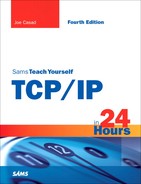IPv6 Addressing
IPv6 addresses, like IPv4 addresses, are assigned by a central Internet authority and distributed through a system of ISPs and other bandwidth providers. As shown in Table 13.2, certain address ranges are reserved for specific activities such as multicasting and link-local addressing (which is similar to the IPv4 zero configuration system described in Hour 12, “Automatic Configuration”). As you learn in the next section, another special range of addresses is reserved for mapping IPv4 addresses to the IPv6 address space.
| Address Type | Binary Prefix | IPv6 Notation | Description |
|---|---|---|---|
| Unspecified | 0...00 (all zeros) | ::/128 | Must never be assigned. Indicates the absence of an address. |
| Loopback | 0...01 (127 zeros) | ::1/128 | Diagnostic address used for a host to send a packet to itself. |
| Mapped IPv4 | 0...0:FFFF (80 zeros) | ::FFFF/96 | IPv6 equivalent for existing IPv4 address. |
| Multicast | 11111111 | FF00::/8 | Identifies a group of hosts. |
| Link-Local Unicast | 1111111010 | FE80::/10 | Use for automatic address configuration. |
| Gobal Unicast | (everything else) |
The 128-bit IPv6 address is taxing for the memory no matter how you express it. As you’ll recall from Hour 4, 32-bit IPv4 addresses are commonly shown in dotted-decimal notation, in which each byte is expressed as a decimal number of up to three digits. This string of 12 decimal digits is much easier to remember than the 32 binary digits of the actual binary address, and it is possible, if you try, to even remember a dotted-decimal address. This method for humanizing a 32-bit address, however, is utterly useless for remembering a 128-bit address. A few conventions have evolved to simplify the intimidating IPv6 address.
An IPv6 address is typically shown as eight colon-separated groups of four hexadecimal (base 16) digits, with leading zeros omitted:
2001:DB8:0:0:8:800:200C:417A
A shorthand trick is to eliminate multiple consecutive blocks of zeros and replace them with a double colon. The preceding address would then appear as:
2001:DB8::8:800:200C:417A
Only one double colon is allowed in any address. The rules for IPv6 address assignment often lead to long strings of zero bits, which makes the double colon especially useful. For instance, the address:
FF01:0:0:0:0:0:0:101
can simply be written as
FF01::101
Like IPv4 addresses, IPv6 addresses begin with a prefix representing the network. An equivalent to the CIDR system (see Hour 5) lets you represent a block of addresses by specifying the first address in the block along with a decimal number representing the number of network bits. According to RFC 4291, “IPv6 Addressing Architecture,” to show the block of addresses with the 60-bit network prefix 20010DB80000CD3, you could write:
2001:0DB8:0000:CD30:0000:0000:0000:0000/60
or
2001:0DB8:0:CD30::/60
Eventually, IPv6 network configuration software will allow the user to define a default network prefix so that manual configuration at the client will only require reference to the host portion of the address. IPv6 also provides sophisticated autoconfiguration features, which reduces the need for typing long addresses at the keyboard.
It’s too early to predict how network administrators will accommodate the formidable IPv6 address, but you can certainly bet name resolution will play an important role on IPv6 networks (see Hour 11, “Name Resolution”).
